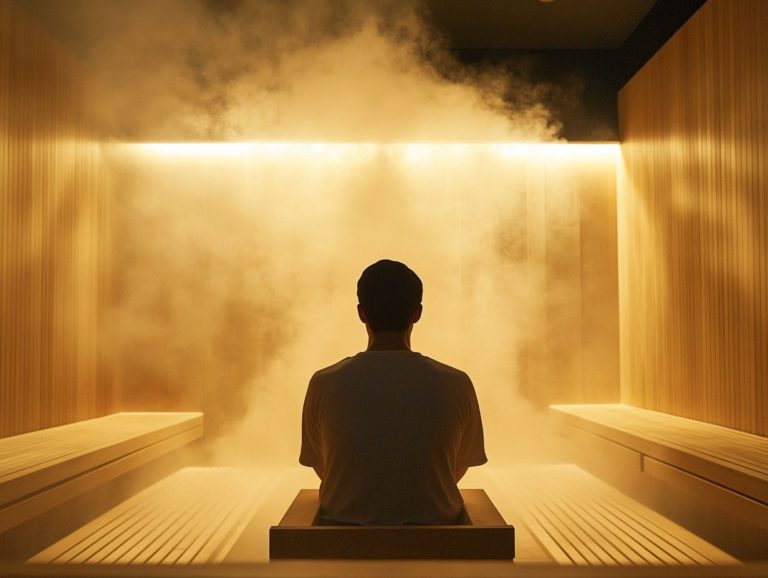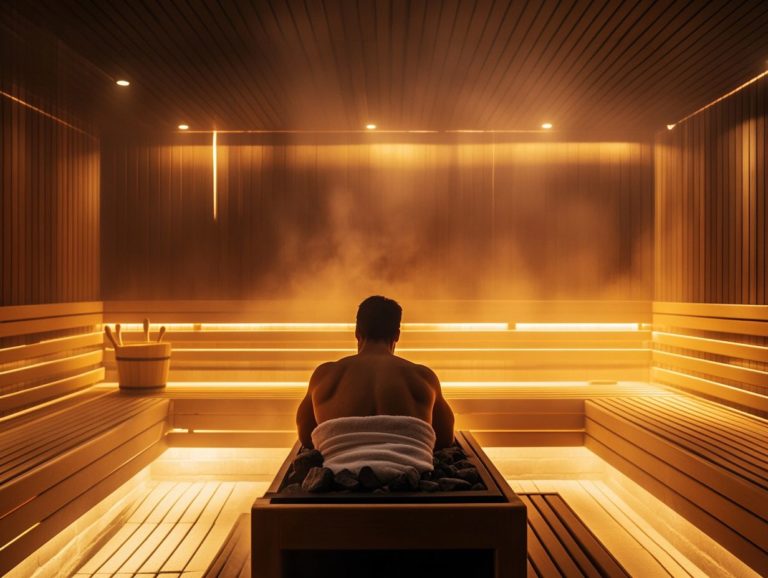Saunas: An Aid for Respiratory Health
Discover the amazing health benefits of saunas that can transform your breathing and lung function!
Saunas have long been revered for their relaxation benefits and their remarkable impact on respiratory health. You ll discover how saunas can enhance your breathing and lung function, exploring the effects of both traditional and infrared options.
Essential safety tips for sauna use will be shared, along with recommendations for seamlessly incorporating this wellness practice into your routine.
Uncover how a bit of heat can significantly benefit your lungs and enhance lung function!
Contents
- Key Takeaways:
- How Saunas Benefit Respiratory Health
- Types of Saunas and Their Effects on Respiratory Health
- Precautions for Using Saunas
- Incorporating Saunas into Your Respiratory Health Routine
- Frequently Asked Questions
- What is a sauna and how can it help with respiratory health?
- Are there any specific types of saunas that are better for respiratory health?
- Can saunas be used as a treatment for respiratory conditions?
- Are there any precautions to take when using a sauna for respiratory health?
- Are there any potential risks for using saunas for respiratory health?
- Can saunas be used as a preventative measure for respiratory health?
Key Takeaways:

- Saunas can help you breathe easier and improve lung function.
- Both traditional and infrared saunas offer unique heating benefits for your lungs.
- Make sure to follow safety tips to maximize your sauna experience and boost your respiratory health!
What is a Sauna?
A sauna is not just any room; it s a dedicated space designed for you to indulge in either dry or wet heat sessions, typically cranked up to impressively high temperatures. Embracing this practice is part of Finnish culture, where the sauna experience is revered. Think of it as your personal retreat for relaxation, offering a unique environment filled with health benefits that go beyond mere comfort detoxification helps remove harmful substances from your body, while supporting immune function means helping your body fight off illnesses.
Originating from Finland, the sauna has a rich history that spans over 2,000 years. It has transformed into various forms, from the traditional Finnish sauna to modern steam rooms. The classic Finnish sauna usually maintains a temperature range of 150 F to 195 F, complete with wooden benches inviting you to sit back and soak in the heat. The experience becomes even more enjoyable as you pour water onto heated stones, creating steam that elevates your level of relaxation.
But it s not just about the physical perks, like improved circulation and skin cleansing. In Finland, saunas also serve as vital spaces for communal bonding among friends and family. They are often viewed as sacred places for social interactions and personal reflection, turning a simple heat session into a meaningful experience.
How Saunas Benefit Respiratory Health
Saunas are celebrated for their myriad health benefits, especially when it comes to enhancing respiratory health and lung function. Regular sauna therapy has shown remarkable potential in alleviating chronic respiratory conditions, such as asthma and chronic obstructive pulmonary disease (COPD), which is a serious lung condition that makes it hard to breathe, ultimately contributing to improved overall lung health.
Improving Breathing and Lung Function
Sauna therapy offers a remarkable enhancement to your breathing and overall lung function, proving to be a valuable ally for individuals grappling with chronic obstructive pulmonary disease (COPD) and asthma. Regular sauna sessions can noticeably improve your breathing, thanks to the heat exposure that effectively reduces inflammation in your respiratory tract.
This therapeutic practice works wonders for your oxygen intake by dilating your blood vessels, resulting in improved circulation throughout your lungs. You’ll find that the moist heat helps your nasal passages, enhancing airflow and making it significantly easier to breathe.
On a physiological level, as your body temperature rises during sauna sessions, it stimulates the release of stress-reducing hormones like norepinephrine, contributing to a profound sense of well-being. Case studies demonstrate that individuals with respiratory conditions experience not only enhanced lung function but also reduced symptoms and a better overall quality of life.
Testimonials from long-term users underscore significant improvements in exercise tolerance and respiratory distress, establishing sauna therapy as a powerful complement to traditional lung treatments, with added benefits for cardiovascular health.
Types of Saunas and Their Effects on Respiratory Health

You can find various saunas, each offering unique benefits for respiratory health. Traditional saunas use dry heat, helping to ease breathing difficulties.
Infrared saunas, on the other hand, heat your body directly with infrared light, a type of light that heats the body directly. Both options can significantly improve respiratory conditions.
Comparing Traditional and Infrared Saunas
When comparing traditional saunas with infrared saunas, the key difference is how heat is delivered and its effects on your body. Traditional saunas use steam or hot rocks for heating, while infrared saunas use panels that directly warm your body, offering distinct respiratory benefits and unique sauna experiences.
Traditional saunas operate at higher temperatures, often exceeding 180 F. This creates a humid atmosphere, making the air feel thick and heavy.
Infrared saunas usually work at lower temperatures, around 120 F to 150 F, providing a more comfortable experience for those who are heat sensitive.
Research shows that using infrared saunas may enhance your respiratory function, as the heat penetrates deeper into tissues, promoting better lung capacity and circulation. Your preferences might vary; some individuals revel in the intense heat of traditional saunas, while others favor the gentler embrace of infrared options.
Scientific studies underscore not only the relaxation benefits of both types but also their potential to alleviate symptoms of respiratory conditions, making them appealing choices for health enthusiasts like you.
Precautions for Using Saunas
While saunas provide significant health benefits, it s crucial to know the risks involved and necessary precautions. Embracing proper sauna safety measures, such as being mindful of dehydration and potential health issues, is a must! This is especially important for individuals with pre-existing breathing difficulties or respiratory conditions.
Prioritizing these considerations will enhance your sauna sessions, allowing you to fully enjoy their health benefits while safeguarding your well-being.
Safety Tips and Considerations
To fully embrace the health benefits of saunas while minimizing risks, it s crucial to follow recommended sauna safety tips. Staying properly hydrated and being mindful of any health conditions that might affect your sauna experience especially if you have breathing difficulties can significantly enhance your time in the heat.
Preparing your body beforehand with a warm shower not only cleanses your skin but also promotes circulation, setting the stage for an optimal session.
While you re inside, keep a close eye on your body temperature; if you start to feel dizzy or too hot, don t hesitate to step out. Setting a timer for your sauna session is essential to avoid prolonged exposure that could lead to dehydration or overheating.
By tuning into your body and recognizing signs of discomfort, you can ensure a safer and more enjoyable sauna experience that aligns seamlessly with your health and wellness goals.
Incorporating Saunas into Your Respiratory Health Routine

Incorporating saunas into your respiratory health routine can yield significant benefits for your lung health and overall well-being. However, grasping the appropriate sauna frequency and session duration is essential.
Engaging in regular sauna sessions, including sauna treatment, not only enhances your breathing but also offers a soothing experience that fosters relaxation and recovery from acute respiratory symptoms.
Recommended Frequency and Duration
To enjoy the health benefits of sauna sessions, prioritize a consistent sauna routine. It should align with your personal health needs and lifestyle. Depending on your lung function and overall well-being, the duration and frequency of your sauna sessions can vary significantly. Stay hydrated to maximize your sauna experience before and after.
If your goal is to boost cardiovascular health, hitting the sauna three to four times a week for 15 to 20 minutes can be particularly beneficial. If relaxation and stress relief are your main objectives, even shorter sessions of 10 to 15 minutes more frequently might do the trick.
Remember, hydration is key. Drinking water before, during, and after your sauna time is vital, as your body will lose fluids through sweat. Listen to your body. Adjust the session lengths based on how you feel.
If you have any underlying health issues or concerns, including COVID-19, it’s smart to talk to a doctor.
Frequently Asked Questions
What is a sauna and how can it help with respiratory health?
A sauna is a small room or enclosure that uses dry heat to create an environment that promotes sweating. This process can help clear the respiratory system by opening up the airways and loosening mucus.
Are there any specific types of saunas that are better for respiratory health?

Infrared saunas, which use infrared light to heat the body rather than traditional heated rocks, have been shown to be more beneficial for respiratory health. This is due to the deeper penetration of heat that can help with inflammation and congestion.
Can saunas be used as a treatment for respiratory conditions?
Although saunas can provide temporary relief for respiratory symptoms, they should not be used as a sole treatment for respiratory conditions. It s important to consult with a healthcare professional for proper diagnosis and treatment.
Are there any precautions to take when using a sauna for respiratory health?
Stay hydrated while using a sauna, as the heat can cause excessive sweating. Limit sauna sessions to 15-20 minutes and avoid using a sauna if you have a fever or other acute illness.
Are there any potential risks for using saunas for respiratory health?
While saunas are generally safe for healthy individuals, those with underlying respiratory conditions such as asthma should use caution. The heat and humidity can trigger symptoms. Ensure proper ventilation in the sauna to avoid overheating.
Can saunas be used as a preventative measure for respiratory health?
Regular use of saunas has been shown to improve overall respiratory health and can potentially help prevent respiratory infections. However, it should not replace maintaining a healthy lifestyle and practicing good hygiene.
Start your sauna journey today and take the next step towards better respiratory health!






